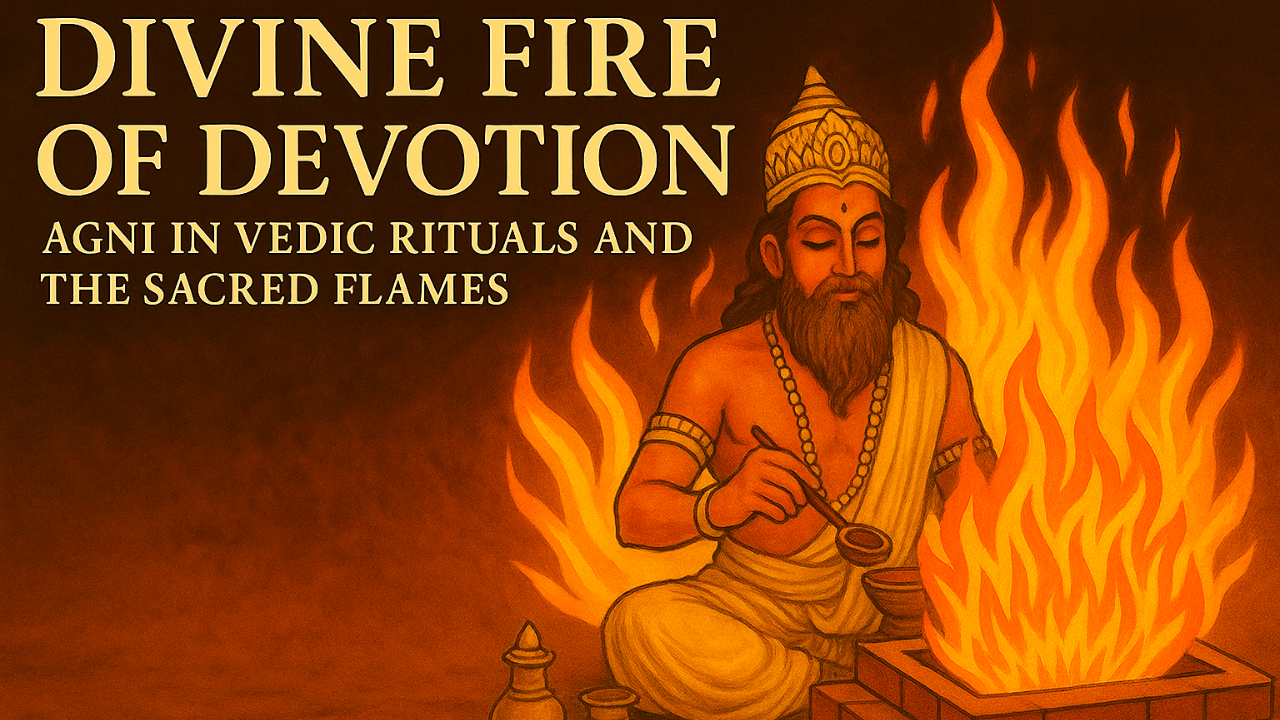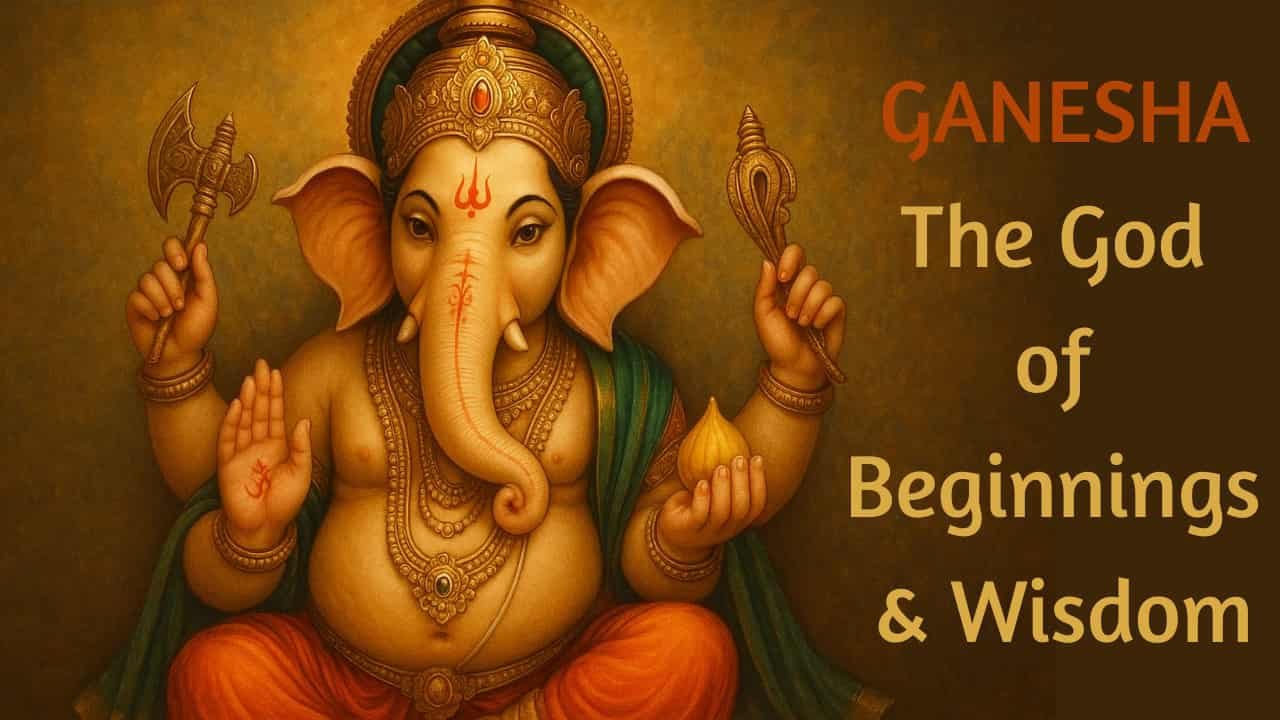
Agni in Vedic Rituals: The Flame That Speaks
In the quiet sanctum of Vedic ritual, where man meets the divine, it is fire that speaks first. Agni in Vedic rituals, the sacred flame, is not merely a tool of worship; he is the worship itself. He is the mouth of the gods, the messenger of offerings, the bridge between the earthly and the celestial.
In every flicker of flame, there is a whisper of prayer, a breath of devotion, a pulse of cosmic rhythm. The fire does not just burn, it listens, responds, and transforms.
Agni in the Vedas
Agni is one of the most celebrated deities in the Rigveda. Over two hundred hymns are dedicated to him, more than to any other god. He is invoked at dawn, at dusk, at birth, at death. He is the first to be called in every yajna, the ritual sacrifice that forms the heart of Vedic spirituality.
Agni in Vedic rituals is not just fire; he is a divine presence, radiant energy, and sacred transformation. His flames are described as golden-tongued, his body as brilliant, his nature as purifying and protective.
The Triple Form of Agni
Agni exists in three realms:
- Terrestrial Agni burns in the hearth and altar.
- Atmospheric Agni flashes as lightning in the sky.
- Celestial Agni shines as the sun, the eternal flame of the heavens.
This triadic form reflects his omnipresence. He is in the home, in the storm, in the stars. He is the fire we see, the fire we feel, and the fire we imagine. These three forms also symbolize the journey of the soul, from the earthly to the divine, from the visible to the eternal.
The Ritual of Yajna
Yajna is the sacred act of offering. Grains, ghee, herbs, and prayers are poured into the fire. The flames rise, carrying the offerings to the gods. Agni in Vedic rituals consumes, transforms, and delivers.
He is the priest, the altar, and the path. In yajna, the material becomes spiritual, the finite touches the infinite. The ritual is not just symbolic; it is a living dialogue between the devotee and the divine, mediated by flame.
Agni in Vedic Rituals: Symbolism of Fire
Fire is transformation. It turns wood to ash, ghee to smoke, prayer to presence. It is both destroyer and purifier. In Vedic thought, fire symbolizes clarity, truth, and illumination. It burns away ignorance, reveals hidden essence, and lights the path of dharma.
Agni in Vedic rituals is the inner fire of awareness, the outer fire of ritual, and the eternal fire of existence. He is the light that reveals, the heat that refines, and the energy that sustains.
Agni as Messenger
Agni is the divine courier. He carries the offerings of humans to the gods. He translates human intention into divine reception. In this role, he is trusted, revered, and loved.
Without Agni, the gods remain distant. With him, they become near. He is the voice that bridges silence, the light that bridges darkness. His flames rise like prayers, his smoke ascends like blessings, his presence sanctifies the space between worlds.
The Sacred Fire in Daily Life
In ancient India, fire was central to daily life. The household fire was kept burning, tended with care, treated with reverence. It was lit at birth, used in marriage, and extinguished at death.
Agni was present in cooking, in warmth, in protection. He was not just a ritual force; he was a living presence. The fire in the kitchen, the lamp in the shrine, the torch in the procession, all were forms of Agni, all were sacred.
Agni in Marriage Rituals
In Hindu weddings, the couple circles the sacred fire. Each round is a vow, a step into shared destiny. Agni in Vedic rituals witnesses the union, sanctifies the bond, and blesses the journey.
The fire is not just symbolic; it is sacred. It sees, remembers, and holds the promise of togetherness. The flames become witnesses to love, guardians of commitment, and carriers of sacred intention.
Agni in Funeral Rites

At death, Agni returns. The body is offered to the flame, released from the earthly shell. The fire purifies, liberates, and transforms. It is the final yajna, the last offering.
Agni becomes the guide to the next realm, the light that leads the soul beyond. In cremation, the fire is not destruction; it is release, elevation, and transcendence.
The Inner Fire: Agni in Vedic Rituals
Agni is not only external. He lives within. The digestive fire, Jatharagni, sustains life. The fire of intellect, Buddhi, guides thought. The fire of aspiration, Tapas, fuels spiritual growth.
These inner flames are reflections of the cosmic Agni. To honor Agni is to honor the fire within. The yogi kindles this fire through discipline, the seeker through devotion, the healer through balance.
Agni and the Rishis
The ancient sages, or rishis, saw Agni as the firstborn of creation. He was the spark that ignited the cosmos. In their hymns, they praised his brilliance, his purity, his power.
They called him the friend of man, the protector of truth, the guardian of dharma.
Agni was not just a god; they saw him as a companion. He was invoked in every rite, remembered in every chant, and revered in every silence.
The Fire Altars
Vedic rituals used elaborate fire altars, or vedis, shaped with precision and symbolism. The Garhapatya fire represented the household. The Ahavaniya fire was for offerings. The Dakshinagni fire was for ancestors.
These altars were not mere structures; they were sacred geometries, cosmic maps, and spiritual engines. Their shapes mirrored constellations, their dimensions encoded mantras, their flames danced with meaning.
Agni in Vedic Rituals and the Cosmos
Agni is cosmic fire. He is the heat of stars, the pulse of planets, the energy of life. In Vedic cosmology, he is the spark of creation, the warmth of sustenance, and the flame of dissolution.
He is present in the sun, in lightning, in volcanic fire. He is the breath of the universe, the heartbeat of time. His presence is felt in the warmth of the womb, the blaze of the sun, and the glow of the soul.
Agni in Ayurveda
In Ayurveda, Agni is the principle of digestion and transformation. It governs metabolism, assimilation, and vitality.
- Weak Agni leads to disease. Strong Agni leads to health.
Ayurvedic treatments aim to balance Agni through diet, herbs, and lifestyle. The body’s fire is sacred; it must be honored. Agni is the healer within, the alchemist of nourishment, the guardian of vitality.
Agni in Mythology
Agni appears in many myths. He was born from the friction of cosmic forces. He hides in water, is found by the gods, and rises to the heavens. He is playful, powerful, and sometimes unpredictable.
Yet he is always sacred. His stories reveal his depth, his mystery, and his divinity. He is the child of the sky and earth, the brother of the wind, the friend of the sage.
Agni in Vedic Rituals: Final Reflections
Agni is not just a god of fire; he is the fire of the god.
He is the light that connects, the heat that transforms, the flame that purifies. In Vedic rituals, he is the beginning, the middle, and the end. He is the sacred thread that weaves devotion, dharma, and destiny.
To understand Agni is to understand the soul of Vedic spirituality. And to honor him is to kindle the fire of truth, within and without. In every flame, there is a story.
In every spark, a prayer. In every fire, a god.

